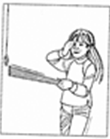早教吧作业答案频道 -->英语-->
Let'strydoingthefollowingexperiment.WhattoDo:Usestringtohangapapercliporothersmallobjectataboutchest(胸部)level.Pickupastick,suchasabroomhandle.Takethreeorfourstepsawayfromthepaperclip.Nowcloseo
题目详情
Let's try doing the following experiment.
What to Do:
Use string to hang a paper clip or other small object at about chest(胸部)level.
Pick up a stick,such as a broom handle.Take three or four steps away from the paper clip.
Now close one eye and walk toward the paper clip.Try to touch it with the tip of the stick.If you miss,try again,still keeping one eye closed.Now try it with both eyes open and see if it's easier to do.
How it works:
In the experiment,you have to judge how far away the paper clip is.Your brain has several ways of doing this.
One simple way depends on how much your eye has to focus(聚焦)itself.Using only one eye,most people will find it difficult to touch the paper clip on the first try,but the brain still gets some information about distance-though not much.
Your brain can judge distance much better when you look at something with both eyes.In fact,your brain has more than one way to use both eyes in judging distance.For example,to see anything clearly,you have to make both of your eyes point at the object.When you look at a nearby object,your eyes turn inward.You can feel this happening if you look at the tip of your finger and move your finger toward your nose.
Your brain gets information from the eyes about how much they are pointing toward each other.Using that information,the brain can tell how far away any object is,whether it is a basketball or a paper clip.
38.How many materials do we need at least to do the experiment?___
A.Two
B.Three
C.Four
D.Five
39.The passage is mainly about that with eyes our brain can judge___.
A.how big an object is
B.how high an object is
C.how far away an object is
D.how much information an object is
40.Which of the following is true according to the passage?___
A.Our brain judges distance in one way when we use both eyes.
B.Our brain cannot judge the distance of a small object but a big one.
C.How much our eyes focus helps our brain judge the size of an object.
D.How much our eyes focus helps our brain judge the distance of an object.
41.From the experiment we can infer(推断)___.
A.with one eye we can see an object as clearly as we use two eyes
B.our eyes turn towards the inside when we look at an object very near
C.within 3 or 4steps,the nearer an object is,the more clearly we can see it
D.our brain can hardly get any information about distance when we use oneeye.
What to Do:
Use string to hang a paper clip or other small object at about chest(胸部)level.
Pick up a stick,such as a broom handle.Take three or four steps away from the paper clip.
Now close one eye and walk toward the paper clip.Try to touch it with the tip of the stick.If you miss,try again,still keeping one eye closed.Now try it with both eyes open and see if it's easier to do.
How it works:
In the experiment,you have to judge how far away the paper clip is.Your brain has several ways of doing this.
One simple way depends on how much your eye has to focus(聚焦)itself.Using only one eye,most people will find it difficult to touch the paper clip on the first try,but the brain still gets some information about distance-though not much.
Your brain can judge distance much better when you look at something with both eyes.In fact,your brain has more than one way to use both eyes in judging distance.For example,to see anything clearly,you have to make both of your eyes point at the object.When you look at a nearby object,your eyes turn inward.You can feel this happening if you look at the tip of your finger and move your finger toward your nose.
Your brain gets information from the eyes about how much they are pointing toward each other.Using that information,the brain can tell how far away any object is,whether it is a basketball or a paper clip.
38.How many materials do we need at least to do the experiment?___
A.Two
B.Three
C.Four
D.Five
39.The passage is mainly about that with eyes our brain can judge___.
A.how big an object is
B.how high an object is
C.how far away an object is
D.how much information an object is
40.Which of the following is true according to the passage?___
A.Our brain judges distance in one way when we use both eyes.
B.Our brain cannot judge the distance of a small object but a big one.
C.How much our eyes focus helps our brain judge the size of an object.
D.How much our eyes focus helps our brain judge the distance of an object.
41.From the experiment we can infer(推断)___.
A.with one eye we can see an object as clearly as we use two eyes
B.our eyes turn towards the inside when we look at an object very near
C.within 3 or 4steps,the nearer an object is,the more clearly we can see it
D.our brain can hardly get any information about distance when we use oneeye.

▼优质解答
答案和解析
答案:38、B 推理判断题 根据题意可知询问做这个实验我们至少需要多少材料?结合短文的第三四两段Use string to hang a paper clip or other small object at about chest(胸部)level...
看了Let'strydoingth...的网友还看了以下:
A是n阶矩阵,r(A+E)+r(A-E)=n,证明A^2=E稍微具体一点行不。 2020-04-05 …
设A是n阶矩阵A^2=E,证明r(A+E)+r(A-E)=n,的一步证明过程不懂由A^2=E,得A 2020-05-14 …
已知字母组合成英语单词1、e e t t i n h r 2、e e r a t w h 3、o 2020-05-14 …
设A为n阶方阵,E为n阶单位矩阵,证明R(A+E)+R(A-E)》n, 2020-05-15 …
设A为n*n矩阵,证明:如果A^2=E,那么R(A+E)+R(A-E)=n 2020-05-15 …
线性代数求解有n阶矩阵A,满足(A+E)(A-E)=0,怎么得出R(A+E)+R(A-E)≤n不懂 2020-06-28 …
在球坐标系中,已知矢量A=e(r)a+e(θ)b+e(φ)c,其中a、b和c均为常数.(1)问矢量 2020-07-21 …
()1.A.Hello,Jack.()2.A.E-R-A-S-E-R.()3.A.Yes,itis. 2020-10-30 …
设A是2阶方阵,且A^2=E,A不等于±E,证明:r(A+E)=r(A-E)=1 2020-11-02 …
1、已知n阶矩阵A满足:R(A+E)+R(A-E)=n,证A(A+2E)(A+4E)-3(A+2E) 2020-11-03 …